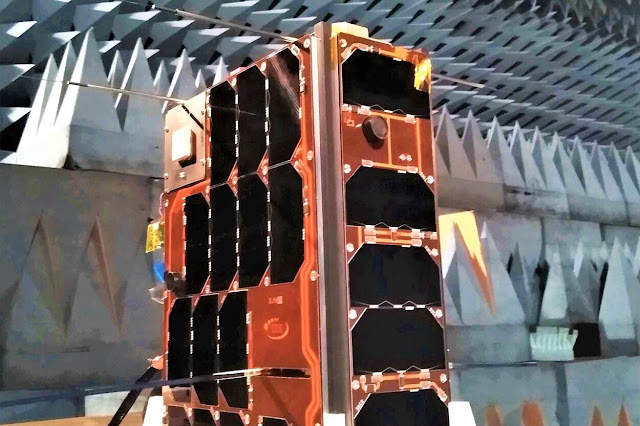 |
| artist impression of Brik-II in space (The Netherlands Ministry of Defense) |
It was originally scheduled for launch in 2019, and postponed several times. But it now seems it will finally happen, on or near June 30: the launch of the Netherlands' first own military satellite, a 6U cubesat named 'Brik-II'.
The ministry of Defense of the Netherlands is partner in several already launched military satellites, but this will be the first satellite that is truely it's own.
Brik-II was built by the Dutch aerospace company ISISPACE in cooperation with Delft Technical University, Oslo University and NLR and will be operated by the Royal Netherlands Air Force (RNLAF).
It is a small 6U cubesat (10 x 20 x 30 cm, weighing 10 kg) that contains equipment for communications relay, for Space Weather monitoring, and for ELINT (see my earlier post on Brik-II here).
 |
| image: The Netherlands Ministry. of Defense |
Brik-II will be launched by Virgin Orbit as part of their 'Tubular Bells, part 1' mission that launches a number of small payloads: apart from Brik-II for the RNLAF, it will launch three or four (sources differ on the number [edit July 1: it were four payloads]) payloads for the US Dept. of Defense, and two payloads for the SatRevolution company.
The launch is an airborne launch, using a two-stage LauncherOne rocket launched from the Virgin Orbit Boeing 737 747-400 'Cosmic Girl' in front of the California coast.
 |
| images: Virgin Orbit |
The launch was postponed several times, including this month, but Navigational Warnings have now appeared indicating an aimed launch date of 30 June (with backup dates July 1-5).
The 3-hour launch window runs from 13:00-16:00 UT [edit: launch eventually was at 14:47 UT]. According to Virgin Orbit, the orbit aimed for is a 60-degree inclined circular orbit at ~500 km altitude. [edit] An infographic by the Royal Dutch Air Force mentions an orbital inclination of 60.7 degrees.
This is the navigational warning, NAVAREA XII 292/21:
262041Z JUN 21
NAVAREA XII 292/21(18,21).
EASTERN NORTH PACIFIC.
CALIFORNIA.
1. HAZARDOUS OPERATIONS, ROCKET LAUNCHING
301300Z TO 301600 JUN, ALTERNATE
1300Z TO 1600Z DAILY 01 THRU 05 JUL
IN AREAS BOUND BY:
A. 33-36-44N 120-23-05W, 33-24-22N 120-17-14W,
32-55-44N 119-55-39W, 30-38-19N 118-13-14W,
28-24-39N 116-37-52W, 28-03-32N 116-17-09W,
28-10-00N 116-05-44W, 28-24-41N 116-11-12W,
29-07-31N 116-36-05W, 30-50-51N 117-46-19W,
33-08-50N 119-32-16W, 33-33-26N 119-54-35W,
33-45-27N 120-06-00W, 33-43-27N 120-16-02W,
33-36-44N 120-23-05W.
B. 23-13-25N 112-20-09W, 23-51-12N 113-00-01W,
24-04-05N 113-17-34W, 24-00-35N 113-35-42W,
23-49-04N 113-49-26W, 23-23-22N 113-46-59W,
22-46-17N 113-39-25W, 22-01-49N 113-03-13W,
21-54-11N 112-57-20W, 21-46-52N 112-49-48W,
21-41-03N 112-38-21W, 21-40-45N 112-26-55W,
21-44-25N 112-12-12W, 21-52-03N 112-03-22W,
22-03-39N 111-58-08W, 22-13-42N 111-57-29W,
22-26-28N 112-02-59W.
2. CANCEL THIS MSG 051700Z JUL 21.
I have plotted the two areas on the map below, along with the trajectory for a 60-degree inclined ~500 km orbit, with times along the trajectory valid for launch at 13:00 UT, the start of the window (it will, however, probably launch a little after that: the second map is for a 60.7 degree inclined orbit and denotes times in minutes after launch):
 |
| click map to enlarge |
 |
| click map to enlarge |
While Virgin Orbit mentions a 500 km target orbit for 'Tubular Bells', earlier news reports on Brik-II mentioned a 600-700 km orbital altitude.
Brik-II is named for an earlier 'Brik', the name of the very first aircraft of the RNLAF progenitor, the 'Luchtvaartafdeeling', 108 years ago, in 1913:
 |
| The first Brik, photographed in 1916. Photo: Netherlands Institute for Military History |
"Brik" has several meanings in Dutch. Originally it was a name for a type of ship (equivalent to the English 'Brig'), and it was also used for carts. Later, it became a name for old bicycles and old, decrepit cars. "Brik" in addition is one of several Dutch names for a brick, hence the mission patch for Brik-II:
 |
| Brik-II mission patch (collection author) |
Update 1 July 2021:
CSpOC TLE's have appeared on Space-Track for 8 objects from the launch: the seven payloads and the LauncherOne upper stage. They have catalogue numbers 48871 to 48878. The first object, 48871, is in a lower orbit of 418 x 504 km and almost certainly the LauncherOne upper stage. The seven others are close together in higher, approximately 495 x 522 km orbits, inclined between 60.66 to 60.70 degrees.
Of these objects, either object D, E, or F (catalogue nrs. 48874, 48875, 48876) appears to be Brik-II.
My pre-launch estimate for the orbit appears to have a quite reasonable agreement with the eventual orbits for these objects (the green arrow and object in the images below indicates my pre-launch estimate. the plot is for 1 July 6:35 UT, about 16 hours after launch):
 |
| click images to enlarge |





